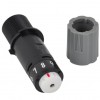I love marquee letters and thought it would be great fun to have some for my daughter's upcoming wedding: they'd look great in photos and as a decorative element at the wedding reception. When I looked at the price tag for shop bought letters my first thought was "I can make those for a fraction of the cost", and I did!
The files are designed by Carina Gardner and the alphabet, numbers and a few other shapes are available from the Silhouette Design Store. The designer has already provided a tutorial on how the letters go together, so I won't repeat it here, but will just provide some information on the small adaptations I made and a few tips which I hope you'll find useful.
WHAT YOU'LL NEED:
For the Letters:
Silhouette CAMEO®
Silhouette 12" x 24" Mat (optional)
Silhouette Chipboard
Flexible cardstock or decorative paper
Battery operated light string(s) (10 to 20 lights per letter)
Card adhesive
Gel adhesive (and ideally a syringe applicator)
For the Stand (optional):
Canvas panel (mine is 60cm x 20cm)
Fabric
Fabric adhesive
Craft knife
Duct/Gaffer tape
Selection
There is quite a learning curve with these letters, especially if you haven't attempted a 3D project before. The letters with straight sides are way easier to put together than the curvy ones. I'd recommend that you do a straight sided one first (H, I, L, M for example) before attempting a curvy one (C, S etc).
Materials
Centre: The central (letter-shaped) portion needs to be very rigid as it provides an interior framework for the whole letter. The Silhouette chipboard is ideal as it cuts even the small light holes beautifully. I used four layers of chipboard for the interior of each letter. Two would be sufficient if they weren't going to be handled much. The files provide 2 sets: one with holes and one without. Use one or the other, you won't need holes if you aren't using lights.
Outsides: The outsides need to be flexible (able to bend without creasing) yet strong enough to not separate at the perforated fold lines. I made a prototype entirely in heavy-weight card and found it didn't crease well around the bends. For the final project I used a rather unconventional media - wallpaper! It is an encapsulated glitter wallpaper and includes a bit of vinyl in the backing, making it both strong, flexible and cuts like a dream.
Lights
Number of Lights: I bought strings of battery operated fairy lights; three strings of lights (2 x 10 bulbs, 1 x 20 bulbs). The individual letters require different numbers of lights. According to the files, I needed 11 for the C, 13 for the Ampersand and 19 for the M. I ungrouped the holes from the centre and reduced the number to fit better with the light strings to 10, 11 and 19. As I was mounting them the Ampersand and M were able to share a bulb. If you are making stand alone letters you'd need to adjust to your string size, or have surplus lights to deal with.
Hole Size: The bulbs on the lights I bought were smaller than the holes in the files. I adjusted the size of the holes to 2mm on 2 out of 4 of the centre pieces so the bulbs fitted snugly. If I'd done all 4, I'd have had difficulty forcing the bulb through (just 2 is more flexible).
Fixing Lights: To make the lights stay put in the completed letters I used gel adhesive applied with a syringe from the rear of the letters where the wires come through. It makes for a neater finish, but means the light strings probably couldn't be used for another project after.
Other file adaptations
Letter Size: The files make letters that are 6" / 15 cm high. I made the letters a little bigger by stretching the files for all three letters at once. I was able only able to do this because my paper was larger than normal and I used the larger cutting mat. Otherwise the letters are already sized to fit on the regular 12" x 12" mat.
Rear of letters: I cut additional centre shapes (with fold line and an offset) to cover the wires at the back of the letters for a neater look.
Platform
I covered the canvas blank with some hessian material using a staple gun to secure the fabric. In order to mount the completed letters I cut slits in the canvas and hessian where they would be hidden by the letters. However, to reduce fraying I first laid down a strip of fabric glue around the future cut area before making the cuts.
The slits were big enough to allow each battery pack to pass through to the underside of the canvas. I then secured the slits and the battery packs with strips of duct tape in a position that leaves the on/off switch accessible.
I stuck the letters onto the platform with strong fabric glue. The letter C isn't able to stand by itself and needed extra support, so I additionally used some brads disguised with silver paper.
Finished Project
I was very pleased with the final result. Certainly not the easiest project that I've ever undertaken, but they do look very impressive and the bride is thrilled with them!
DESIGNS USED:
 |
 |
 |
 |
PRODUCTS USED:

|
 |
 |
 |  |
 |
















Ohhh I can foresee a G & J being made for their new flat! Love these Janet.
ReplyDeleteI'm a fan too. I have plans to make at least one more ' &', if not two.
Delete